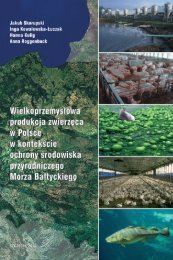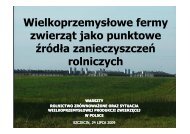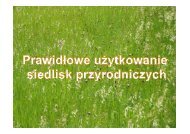best available technologies for manure treatment - Baltic Green Belt
best available technologies for manure treatment - Baltic Green Belt
best available technologies for manure treatment - Baltic Green Belt
Create successful ePaper yourself
Turn your PDF publications into a flip-book with our unique Google optimized e-Paper software.
Best Available Technologies <strong>for</strong> <strong>manure</strong> <strong>treatment</strong> baltic sea 2020<br />
2: METHODOLOGIES AND ORGANISATION<br />
basis <strong>for</strong> a common understanding of the type of<br />
<strong>technologies</strong> the project focuses on:<br />
• Dealing widely with <strong>manure</strong> handling,<br />
processing and treating, comprising mechanical,<br />
thermal, chemical, biological and probably other<br />
• Focusing on <strong>technologies</strong> that are relevant <strong>for</strong><br />
industrial pig farming in the <strong>Baltic</strong> Sea Region<br />
• Focusing on <strong>technologies</strong>, which in a cost efficient<br />
way minimize N and P leaching from <strong>manure</strong><br />
• Excluding conventional <strong>technologies</strong> <strong>for</strong> <strong>manure</strong><br />
storing and spreading, which have (or should<br />
have) been en<strong>for</strong>ced several years ago according<br />
existing legislation<br />
• Excluding <strong>technologies</strong> focused on reduction of<br />
smell and airborne emissions<br />
• Focusing on <strong>technologies</strong> which have become<br />
more widespread since the introduction of the<br />
IPPC directive, <strong>for</strong> instance separation, aerobic<br />
<strong>treatment</strong>, anaerobic <strong>treatment</strong>, incineration,<br />
flocculation, flotation, reverse osmosis, etc.<br />
It is also emphasized, that this report does not consider<br />
various trademarks, brands, solutions or concepts<br />
offered by individual producers – behind those<br />
are typically a clone of the <strong>technologies</strong> mentioned,<br />
and/or one or more <strong>technologies</strong> that are optimised<br />
<strong>for</strong> specific purposes.<br />
2.1.4: Definition of leaching<br />
Understanding of the word “leaching” varies in different<br />
countries.<br />
Native English speaking countries normally understand<br />
• leaching as percolation to the soil layers; and<br />
• run-off as washing away along the soil surface,<br />
closely associated with erosion.<br />
There are in the native languages in the <strong>Baltic</strong><br />
Sea Region (BSR) countries normally no linguistic<br />
distinguishing between leaching and run-off.<br />
The term “leaching” is consistently used to<br />
describe all N and P reaching the <strong>Baltic</strong> Sea, either<br />
through leaching or run-off.<br />
2.1.5: Building on the Reference Document<br />
on Best Available Techniques <strong>for</strong> Intensive<br />
Rearing of Poultry and Pigs (BREF)<br />
concerning pigs<br />
The current BREF document (European Commission,<br />
2003) contains about 1 page summary (page xvi<br />
and xvii) and 5 pages detailed description (from page<br />
77 to 82) about “on-farm <strong>manure</strong> <strong>treatment</strong>” of <strong>manure</strong><br />
from pigs and poultry, and lists up <strong>technologies</strong>,<br />
which can be used of the following reasons - citation:<br />
1. To recover the residual energy (biogas) in the<br />
<strong>manure</strong>;<br />
2. To reduce odour emissions during storage and/or<br />
land spreading;<br />
3. To decrease the N content of the <strong>manure</strong>, with<br />
the aim of preventing possible ground and surface<br />
water pollution as a result of land spreading and<br />
to reduce odour; and<br />
4. To allow easy and safe transportation.<br />
The listing of <strong>technologies</strong> in this report comprises<br />
the listing in the BREF document, excluding <strong>technologies</strong><br />
that are not in focus <strong>for</strong> this project, such as<br />
those related with chicken <strong>manure</strong> or odour emissions.<br />
We furthermore find it relevant to structure<br />
the <strong>technologies</strong> according their logistic route from<br />
the source (pigs) to the end disposal (mainly field<br />
application), and to estimate the leaching reduction<br />
potential conditional in relation to a given situation<br />
on the farm.<br />
2.1.6: Model farm <strong>for</strong> scenario calculations<br />
The complete list of <strong>manure</strong> <strong>treatment</strong> <strong>technologies</strong><br />
requires an estimation of the cost efficiency of the<br />
leaching reduction. It is <strong>for</strong> this purpose necessary to<br />
make a few assumptions. In order to rationalise this<br />
as well as to make the comparison and competitiveness<br />
of the various <strong>technologies</strong> more clear, we have<br />
developed five farm scenarios.<br />
• Scenario I describe a model farm, where spreading<br />
of N and P is done in an environmentally safe<br />
way, meaning according to the EU and HELCOM<br />
regulations on the agricultural land of the farm.<br />
21








